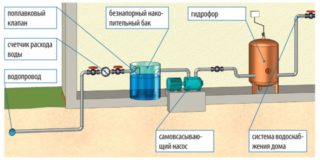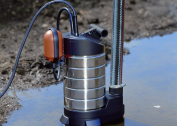In order to constantly supply water to the suburban area for domestic and household needs, it is advisable to immediately mount the water supply system of a private house with an accumulation tank and a pump. Such a highway will allow the owners of the cottage to use the amenities without bringing communal networks to the village.
The principle of operation and device
The highway works on the principle of a pumping station:
- Water enters the storage tank from the source (well / well). It is dialed until the float switch responds to an extremely high level. The fluid is pumped.
- As soon as the water reaches the upper limit, the unit turns off and the storage tank constantly maintains a supply of fluid in the system.
- When you open the tap in the house, water begins to flow into the pipes of the highway. The drive is empty partially or completely.
- The float switch starts the pump and it again pumps the liquid into the tank to the upper limit.
A water supply system with a storage tank is good in such situations:
- low productivity of an autonomous source on the site;
- the presence of a centralized highway, but the water supply by the hour;
- Autonomous water supply system, powered by electricity, but at the same time electricity is supplied to the village intermittently.
The storage tank will be a real panacea for the residents of a country house.
Storage Criteria
To determine the type / size of the tank, you should rely on such criteria:
- Type of material the drive is made of: polymer, galvanized steel, cross-linked polyethylene. More often, masters prefer to deal with polyvinyl chloride or HDPE. They are resistant to corrosion, mechanical stress, aggressive environments. The weight of the polymer is several times less than metal, so the installation of the storage tank will be simpler.
- Design. You can take the tank closed (membrane) type or open. The first is a completely sealed tank with a useful volume of one third less than its visible dimensions. The second - has a cover / hatch, but sealed walls and bottom.
- Type of tank location. If a top tank installation is provided (in the attic or water tower), it is better to give preference to a polymer tank with smooth outer walls. With the lower location of the drive, it is better to take a tank with stiffeners. They help to maintain the integrity of the polymer under pressure on the soil.
- The volume of the drive. On average, for a family of 2-3 people it is better to take a tank for 100-150 liters. With economical water consumption, this is quite enough. Next, it is worth relying on the individual needs of residents. It is important to remember that an open-type and high-volume tank will silt faster. Experienced experts do not recommend putting the drive more than 250 liters for long-term storage of liquid.
When selecting a tank volume, the following should be considered:
- the smaller the tank displacement, the more often the pump will turn on;
- with a larger volume of the drive, it takes longer to fill up - long-term operation of the pumping equipment consumes electricity;
- if the tank has a modest displacement, pressure drops in the system occur more often.
Every 10 m of the height of the container at the top mounting add 1 bar of pressure in the system. With the lower tank device, you will have to use an additional pump to supply water from the reservoir to the pipes.It is better to put a hydraulic accumulator.
Installation Steps
 The storage tank is installed only on a specially prepared site. It can be a welded frame or a concrete reinforced structure. They must support the weight of a fully filled tank. If the installation of the tank will be carried out in the attic, such work must be taken into account even at the design stage of the cottage, otherwise the load-bearing walls may not withstand the mass of the drive with water.
The storage tank is installed only on a specially prepared site. It can be a welded frame or a concrete reinforced structure. They must support the weight of a fully filled tank. If the installation of the tank will be carried out in the attic, such work must be taken into account even at the design stage of the cottage, otherwise the load-bearing walls may not withstand the mass of the drive with water.
Once the tank is installed, you need to connect the inlet and outlet pipes to it. The first can have any cross section, since the fluid is supplied under pressure. For the outlet pipe, it is better to take a hose with a size (diameter) of 1.5-2 times larger than the clearance of the line.
The connection scheme provides for the presence of an unpressurized type of float switch in the tank. Here, on the input, you need to install a check valve, which will prevent the outflow of liquid into the source. Before him put a shut-off valve.
Be sure to mount the coarse filter on the input. A water meter is placed behind it (for centralized highways).
A hose should be provided to discharge excess fluid into the sewer or outside the cottage. It is also useful when flushing the drive.
When installing the tank, you must take care of its insulation. In the ground this can be done using expanded clay dusting. For the upper tank installation, it is desirable to have a warm attic or wrap the container with heat-insulating materials. You also need to qualitatively insulate the pipeline.
Operation and maintenance
As a rule, the storage tank for water does not require special maintenance. But it’s still worth carrying out some measures during the operation of the tank:
- The accumulator (sealed container) should be checked for integrity once every six months. The tank requires special attention if the pressure in the system drops for no apparent reason.
- An unpressurized tank should be washed regularly from accumulated sludge. To do this, turn off the pump, from the system naturally drain the water. Using a brush on a long handle, they process the walls of the tank. Then open the shutoff valve of the hose, which leads to the sewer. Thus, the tank is washed twice and then filled again for further operation.
When washing the tank, it is forbidden to use any chemical household detergents, otherwise their remnants will fall into the mains.
Advantages and disadvantages of storage tanks
Of the positive aspects of autonomous communication, there are:
- a constant supply of water at home, even if the productivity of the well / well is poor;
- optimal pressure in the system and fluid supply to the valves with normal pressure;
- the ability to not depend on the cyclical operation of utilities (water utilities, power networks).
Of the minuses note:
- the complexity of installing the tank;
- the need for regular washing;
- fast silting of an unpressurized drive;
- the possibility of the formation of an unpleasant odor of stagnant water with an incorrectly selected tank volume;
- additional energy consumption during pump operation;
- the need to warm the soil above the tank.
Despite all the difficulties, a water supply system with a drive is preferable to a direct supply of liquid from a well / well into a house.



